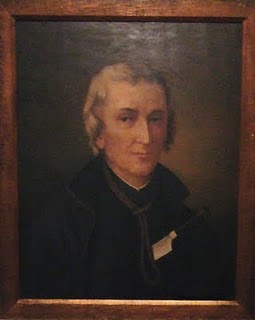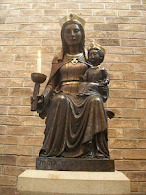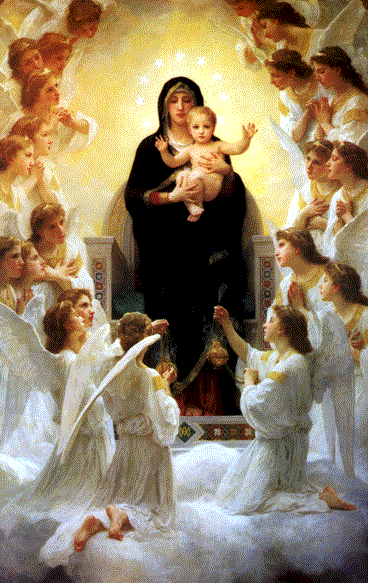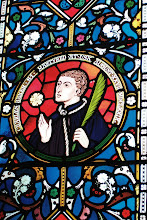The Masonic Hall in St John’s
Street, Abergavenny, occupies the site of an ancient Roman Catholic Church. The Church, St John’s, began life as
Abergavenny’s Parish Church. A curfew bell in the tower was rung each
evening to warn residents that the town gates were closing for the night. Although the original building was taken
down and rebuilt, the tower, which dates from the 14th century,
still remains.
 |
| The 14th century Tower |
By the
Dissolution of the Monasteries (1536-1541) more people were attending the
Priory Church of St Mary so the Priory became the Parish Church. At the request of the people King Henry VIII
gave the tithes from the priory to establish the King Henry VIII Grammar School
in the redundant St John’s Church.
King Henry VIII
Grammar School opened in 1542. When the school opened it had 26 pupils, all
boys, between the ages of 7 and 14. The
school’s first Headmaster, one Richard/Nicholas Oldsworthy, was appointed by
the King himself. Oldsworthy was said to
be “learned and instructed” and had an M A degree. A description of the necessary qualifications
for a 16th century Headmaster might cause us to smile or perhaps
even gasp! It was pointless to apply
unless you were “A graduate of one of the universities, not under seven and twenty
years of age, skilful in the Greek and Latin tongues, a good poet, of a sound
disposition, NEITHER A PAPIST NOR PURITAN, of good behaviour, of a sober and
strict conversation, no tippler or haunter of alehouses, no puffer of tobacco
and, above all, be apt to teach and severe in his government”. Would any of you like to apply?
The main
purpose of the school, as outlined in the Letters Patent, was the teaching of
Latin Grammar. The teaching was to be
the responsibility of a master sufficiently versed in Latin. He was to receive an annual salary of £13 6s
8d. An usher or assistant master was
also appointed and received an annual salary of £6 13s 4d.
Grammar Schools
in the 16th century accepted boys from the age of seven and they
usually attended for six or seven years.
In summer the school day began at 6:00 am and continued until 11:00am. The afternoon session was from 1:00pm,
ending at 6:00pm. Due to winter
darkness, things were a little easier in winter. Classes didn’t begin until 7:00am with the usual break at 11:00am. Back again at 1:00pm, classes broke up early
– at 5:00pm! Just as today, the boys looked forward to
their school holidays. Twice a year they
enjoyed a break of about fifteen days!
The boys had to
supply their own candle and slate and they spent their days in the study of
Latin grammar, logic, rhetoric, arithmetic, music, poetry and astronomy. If a boy misbehaved, he was put into a basket
and hoisted up to the rafters. Here he
remained for the rest of the day.
 |
| A Naughty Boy in a Basket! |
King Henry VIII
Grammar School, Abergavenny, can claim many prominent Old Boys. The school numbers among its former pupils Dr
David Lewis, first Principal of Jesus College, Oxford, Dom Augustine Baker, Benedictine
writer and mystic, and St David Lewis, the Jesuit Martyr.
St David Lewis
was born in Abergavenny in 1616 to Morgan Lewis and Margaret Pritchard. Margaret Pritchard was a devout Catholic but
her husband conformed to the new Established Religion. Eight of their nine children were brought up
as Catholics. Morgan Lewis ensured that
their youngest, David, was brought up in the Protestant Religion.
Morgan Lewis
was Headmaster of King Henry VIII Grammar School and his youngest son attended
his school. Since Morgan’s wife was a Catholic
and there were a number of recusant children attending the school, Morgan and
the school came under suspicion of being a centre of recusancy in
Monmouthshire. William Herbert of Coldbrook
was not a particularly influential member of Monmouthshire society so it is
quite likely that his ties to William Herbert, 3rd Earl of Pembroke,
account for his election for Monmouthshire in 1626. Mr Herbert, known to be a ‘godly Protestant’,
was nominated to committees for bills to direct the true conformity of popish
recusants. He was the Member of
Parliament who alerted the Committee of Religion to the suspicions of popery
surrounding Morgan Lewis. Subsequently,
questions arose in the Parliament of 1626.
However, Morgan was reported to be “very conformable” and he and his
career were able to survive the questioning.
This building
housed the King Henry VIII Grammar School until 1898 when a new school was
built at Pen-y-Pound. The former
Catholic Church, turned Grammar School, became a Masonic Lodge.
Holy Trinity
Church in Baker St, Abergavenny, is a pretty and welcoming church erected and
endowed by Miss Rachael Herbert in 1840.
Miss Herbert was the daughter of Charles Herbert who made a fortune as a
dealer in iron in Abergavenny and was a descendant of William Herbert. Although a relatively ‘new’ church, Holy Trinity has some very interesting historic
links.
The stone slab
of Holy Trinity’s present altar was originally that of the ancient parish
church of St John. It was discovered by
Iltyd Gardner and Fred Gardner walled up in a chimney breast of the old Cow Inn in Neville Street.
 |
| The Former Cow Inn |
 |
| The Plaque on the former Cow Inn, Neville Street |
The Gardners presented this valuable piece of
Abergavenny History to Holy Trinity Church.
The consecration marks, roughly cut, are still visible in the stone.
 |
The original Altar Stone from the ancient Church of St John,
in Holy Trinity Church, Abergavenny |
In the sanctuary of Holy Trinity one can see an early English piscina. This piscina was found in the wall of the north transept of the old St John’s Church and presented to the church by the Worshipful Master and Brethren of the St John’s Lodge of Freemasons.
 |
| The Piscina from St John's Church, in Holy Trinity Church, Abergavenny |
Catholic Church; Boys' Grammar School; Masonic Lodge. If only this building could talk!















.JPG)

.JPG)




